New to the world of affiliate marketing? Or maybe you’re looking for new affiliate programs to help you make more money online.
Either way, searching out our Amazon affiliate program review is a great starting point. Well done!
Whatever your thoughts on Amazon as a company, there are a lot of obvious “plus points” to the Amazon affiliate program.
Everyone’s heard of Amazon.
It’s one of the world’s most-trusted brands, so it’s comparatively easy to convince your readers to click your affiliate link and buy.
With an inventory of more than 350 million products, it sells pretty much everything. Even if you’re in a highly specific niche, chances are Amazon has products to match.
It ships to more than 100 countries, so unlike many affiliate programs, it has plenty of potential to monetize international traffic.
And it’s the most popular affiliate program by far. According to our affiliate marketing statistics page, 58.5% of affiliate marketers use Amazon to monetize their content.
So it’s an open-and-shut case, right?
The Amazon affiliate program is the best thing since sliced bread, and if you don’t sign up right now, you’re insane.
You should know by now that nothing in the world of affiliate marketing is that simple.
While there are lots of upsides to being an Amazon affiliate, there are also plenty of downsides.
So before you register, do yourself a favor and dive into our Amazon affiliate program review…
What Is Amazon Associates Program
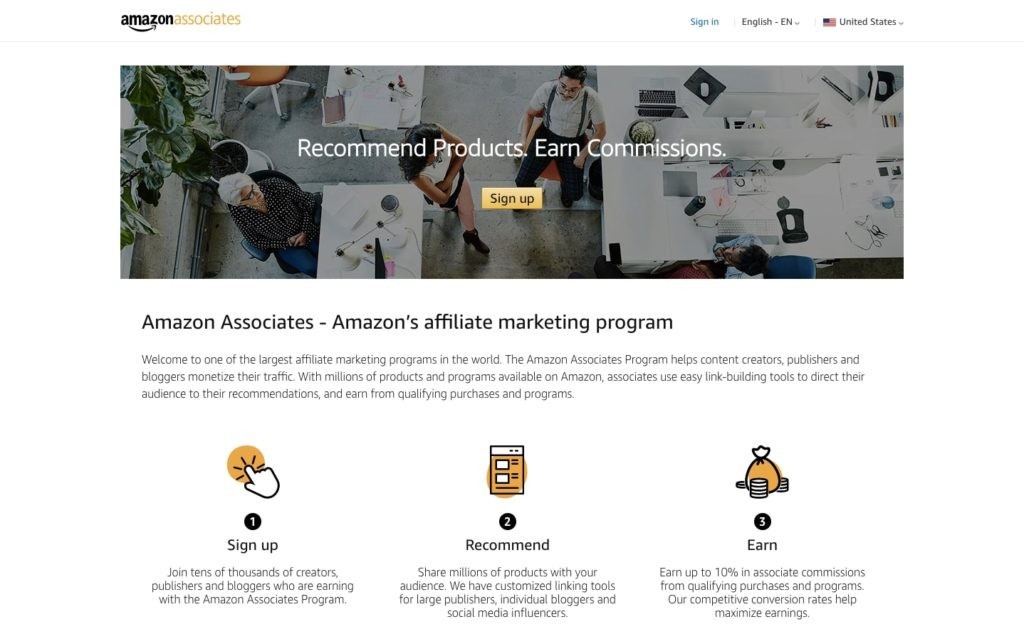
Let’s start by clearing up some terminology.
Amazon’s affiliate program isn’t actually called “the Amazon affiliate program”.
Because that would be too easy.
Instead, it’s called Amazon Associates.
Amazon Associates is an affiliate marketing program through which anyone with an online audience — website owners, affiliate bloggers, social media influencers — can create links and earn referral fees when someone clicks those links and buys a product from an Amazon site.
Actually, it’s not just “an affiliate marketing program”.
It’s one of the largest affiliate programs on the planet.
Like the vast majority of other affiliate programs, it’s totally free to join.
And it’s pretty easy to use:
Just create your Amazon affiliate links, write quality content to promote a product (or products) on Amazon, and you’ll earn money for every purchase.
To make your job easier still, Amazon runs regular retail promotions — things like fixed discounts and free shipping offers — designed to help affiliate marketers drive traffic.
How to Become an Amazon Affiliate
Joining Amazon’s affiliate program is a relatively simple process.
Either search Google for the phrase “join Amazon affiliate program”, or cut out the middleman and click this link.
You’ll arrive on a landing page with a big yellow “SIGN UP” button toward the top:

Clicking that button is the first step toward creating your Amazon Associates account. Exciting stuff!
You’ll be asked for some basic information like your:
- Name
- Address
- Phone number
Next, it’s time to list the “digital properties” — that is, websites and/or apps — on which you intend to advertise products through Amazon Associates.
As a minimum, you need to add at least one website or one app.
But if you’ve got a digital portfolio to rival Unilever’s, you can add up to 50 apps or sites.
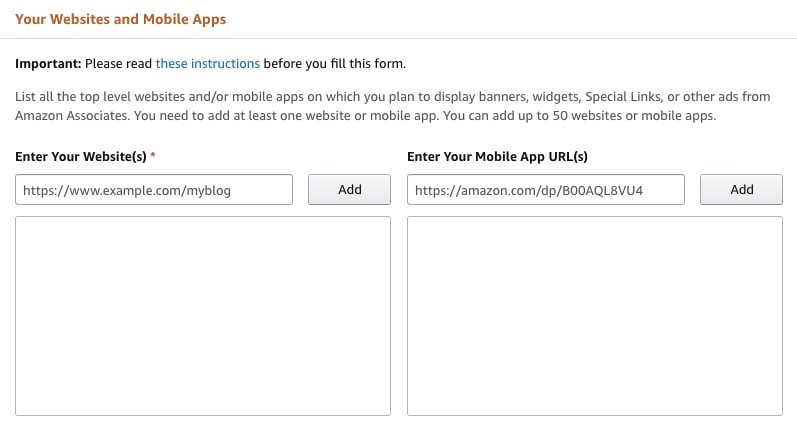
You’ll also be asked to confirm that your sites/apps aren’t directly targeted at under-13s.
So far, so simple.
Now we’re getting to the really important stuff.
Stuff like choosing your Amazon Associates store ID:

And explaining, to the best of your ability:
- What your website is about
- The specific niche you’re targeting
- The types of product you plan to promote

Don’t sweat this section too much.
Fact is, if you’re only just launching your own site, you might not know the answers to all those questions.
Or you might start off down one path then pivot a couple months later when you understand more about your audience and strengths.
That’s fine.
Amazon might not be famed for its generosity, but it won’t take you to court if you don’t know every single thing about your affiliate marketing business at this stage.
You can always alter your answers down the line if things change.
But the interrogation isn’t quite over yet.
Next, Amazon asks a bunch of questions about how your website generates traffic and affiliate revenue.
Are you relying on paid traffic? Email referrals? SEO? The All-Seeing Amazon wants to know.
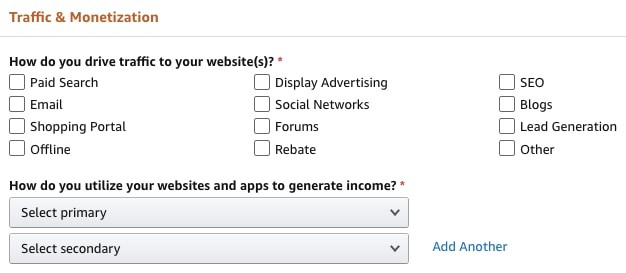
It even asks you how much traffic you’re generating at the moment:

One piece of advice:
In affiliate marketing as in life, honesty is the best policy.
If your website has only existed for a week, don’t tell Amazon you’re driving 500,000 unique visits a month.
Even Amazon itself started out with zero visitors.
It has absolutely no problem working with — and monetizing — new websites, so a lack of traffic won’t count against you.
Slightly confusingly, Amazon also asks how you usually create links:
To be clear, this isn’t an SEO question.
It’s not asking about the finer points of your backlink strategy.
Instead, Amazon wants to know how you construct outbound links:

The top option (Blog Editor) will be the best answer for most would-be Amazon affiliates.
And that’s pretty much it!
When you complete this step and verify that you are who you claim to be, you’ll be automatically approved for the Amazon affiliate program.
Congratulations, you’re a fully fledged Amazon Associate!
But don’t get too carried away, because the hard work hasn’t even started yet.
The Amazon Associates team will only check your application once you’ve driven the requisite number of qualified sales.
To be precise, you need to achieve three sales within your first 180 days in the Amazon Associates program:

While that shouldn’t be an issue for experienced affiliates with established audiences, it’s a very different matter for anyone with a brand new website.
According to Ahrefs, 95% of newly published pages don’t reach the first page of SERPs within a year.
If my math is correct, 180 days = six months.
And six months is less than a year.
So you can’t expect to rely solely (or at all) on organic search traffic to rack up those three qualified sales.
Unfortunately, you can’t just buy three products yourself, because personal orders don’t count.
In short, you’ll need to be smart to cut it as an Amazon affiliate.
That could mean:
- Building an email list to promote your affiliate content
- Investing in PPC to drive paid traffic to your site
- Sharing content on social media
For more practical advice, check out Authority Hacker co-founder and all-round affiliate marketing genius Mark Webster’s guide to making money with the Amazon affiliate program.
What Is the Amazon Affiliate Program Commission Rate
I know what you’re thinking:
Seems like it requires a lot of leg work to make it as an Amazon affiliate.
So is it worth my while?
Am I going to earn a million dollars overnight?
Sadly, no.
I can assure you that, just like all the other affiliate programs out there, Amazon Associates isn’t a get-rich-quick scheme.
Anyone who tells you otherwise is likely trying to scam you into buying their exclusive (and useless) “affiliate marketing secrets”.
Now, Amazon isn’t exactly known for offering the most generous commissions.
It’s slashed its commission rates before, most recently in April 2020.
But there’s still plenty of affiliate revenue to be earned if you choose the right niche.
Just check out Amazon’s current commissions:
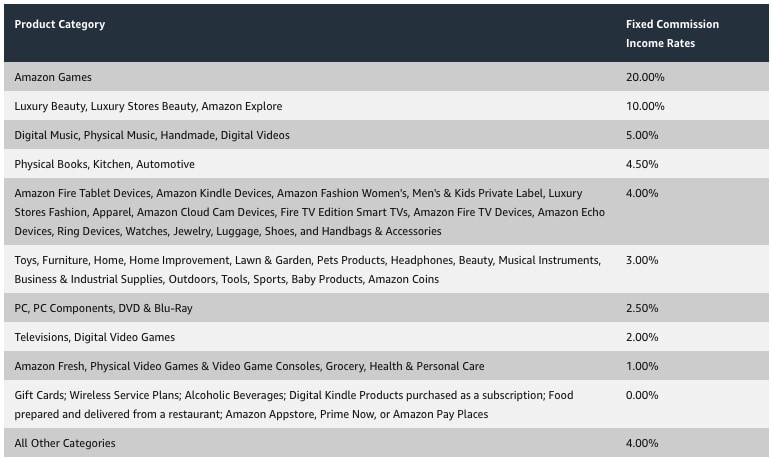
That’s right — at time of writing, Amazon pays affiliates a whopping 20% per sale on digital video games through its Amazon Games division.
Not only that, but sales of luxury beauty items and Amazon Explore’s digital products will net you a tidy 10% commission.
Of course, other categories pay slightly (or much) less.
Because Jeff Bezos didn’t become a billionaire by being generous.
For instance, the home improvement category pays a pretty measly 3%.
So do sales of Amazon Coins (whatever they are), while PC components pay 2.5%.
However many sales you drive, you’re not going to earn much of a living on 1% commissions in the health and personal care product category.
And don’t even think about advertising booze, wireless service plans, or digital products for Kindle, because you’ll earn a big, fat nothing for your efforts.
a) you actually enjoy and
b) has lots of growth potential.
As well as those product category-based commissions, there’s the Amazon bounty program.

With “bounties”, you’ll receive payments of a fixed amount for driving specific actions.
For instance, at time of writing, the Amazon bounty program is paying:
- $3 when “eligible customers” sign up for the Amazon Baby Registry and add at least one product to it
- $5 per eligible purchase of an Amazon Prime gift membership
- $15 for driving a successful registration for an Amazon Business account
It’s unlikely you’ll be able to build an online business based solely on bounty payments.
But they can be a nice way to make more money on top of your existing affiliate earnings.
Currently, nearly 40 different products, services, and actions are eligible for bounty payments — far too many to list here.
So get into the habit of checking the commission web page to ensure you don’t miss out on any opportunities.
What About the Amazon Associates Cookie Duration
No Amazon affiliate program review would be complete without discussing its much-maligned cookie window.
For the uninitiated, a cookie window — or cookie duration, or cookie length — reflects how soon the potential buyer has to make a purchase in order for you to earn a commission.
Most affiliate programs have a cookie duration of about 30 days.
That means if someone clicks your special link today but doesn’t actually buy for another 29 days, you still get a cut of the sale.
The Amazon affiliate program is a little… different.
It offers a measly 24-hour cookie window.
So you earn commission income on any qualifying items placed in a customer’s shopping cart within 24 hours of their arrival via your Amazon link.
You know the song:
“What a difference a day makes, 24 little hours.”
The lyricist Stanley Adams got that right — 24 hours isn’t very long at all.
But don’t despair, because it’s not all bad news.
For starters, the Amazon site is a lean, mean, conversion-driving machine.
Its conversion rate is sky high — around the 10% mark, by some estimates — so there’s a good chance the people you refer will actually buy.
Not only that, but Amazon’s cookie window is actually more generous than initially meets the eye.
Per the terms and conditions of the Amazon program:
“It is of course possible that a customer may arrive at Amazon.com via your Associates link, add an item to his Shopping Cart, and then leave Amazon.com without placing an order. As long as the item was added to the customer’s Shopping Cart during this 24-hour window, you will still earn a referral commission if the order is placed before the Shopping Cart expires (usually after 90 days).”
In other words, as long as people click your Amazon links and add-to-bag within a day, you’ll still earn a commission even if they don’t buy for up to 90 more days.
Doesn’t sound so bad now, does it?
Pros of the Amazon Associates Program
Remember: we don’t have any skin in the game here.
It doesn’t matter to us if you sign up for Amazon Associates or not.
But it’s hard to deny there are some big advantages to creating an Amazon affiliate account.
By our reckoning, here are the five biggest benefits:
1It’s Easy to Use & Build Links
Generally speaking, Amazon’s affiliate program is pretty user-friendly.
The Amazon Associates dashboard is intuitive, the signup process is relatively plain sailing, and the process of building Amazon links is simple, thanks to a little thing called SiteStripe.
What’s SiteStripe?
Well, in Amazon’s own words, it’s a “convenient desktop link-creation tool that eliminates the need to visit Associates Central”.
By using SiteStripe, you can build your Amazon affiliate links while you’re browsing a specific page.
Trust me: That’s a big-time saver.
To display SiteStripe on an Amazon shop page, follow these simple steps:
- Click on “Tools” in Associates Central and choose “SiteStripe”
- Scroll down and click “Learn more”
- Click “Enable” in “Display Status”
Now, you should automatically see the SiteStripe bar at the top of every Amazon web page you view:

If you don’t see it, try re-entering your Amazon Associates program registration data and refreshing the Amazon site.
Hey, presto! SiteStripe should appear.
Now, every time you create a link using SiteStripe, it’ll be automatically attributed to your store ID.
Just copy and paste the special link, and you’ll earn commissions from any sales that originate from your website.
In short: with the Amazon affiliate program, it’s super simple to build text links that are guaranteed to track correctly.
This means no need to worry that you’re not being paid for all the sales you sent Amazon’s way.
2Signup Is Totally Free
Okay, so this one’s a pretty low bar, but just like the vast majority of other affiliate programs, it won’t cost you a cent to set up an Amazon account and start monetizing your traffic.
Amazon might “trim” its commission rates from time to time, but at least it hasn’t actually started demanding payment from affiliate marketers (yet).
3Amazon Is Great at Converting & Optimized for Buying
I’ve said it before, and I’ll say it again: Amazon is amazing at driving conversions.
How amazing!
Well, according to Adoric, the average e-commerce site converts at a rate of 1% – 3%.
Naturally, conversion rates vary by industry, dropping to 1.4% in consumer electronics and climbing to 4.9% for gifts.
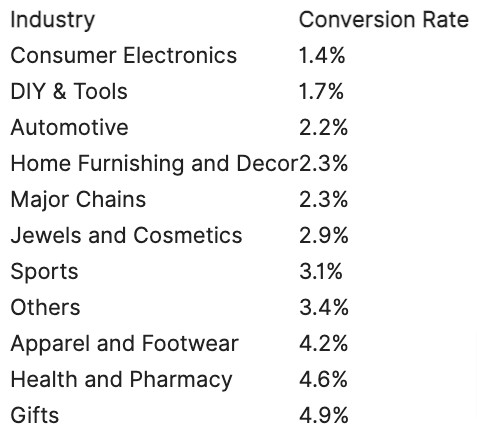
So really, most websites will be delighted if one in every 20 visitors ends up converting.
But Amazon isn’t “most websites”.
According to Ad Badger, Amazon’s conversion rate is a world-beating 9.87%.
That’s more than twice as high as the average site can ever hope to achieve.
Other estimates suggest Amazon is even better at converting.
For instance, a study from website traffic measurement firm Millward Brown Digital claimed the average Amazon Prime member buys a frankly ridiculous 74% of the time, while non-members convert at a still healthy 13%.
Bear in mind there are 200 million Amazon Prime members worldwide, with 112 million in the US alone.
So there’s a good chance a decent chunk of your audience is signed up to Amazon Prime, which in turn means they should convert at a high rate.
4Lots of Products to Promote
While I haven’t actually done the math, I refuse to believe that any other affiliate program can match the sheer wealth of products covered by Amazon Associates.
Whether your niche is in Colonel Sanders fan fiction, kangaroo jerky, or radioactive uranium ore, as long as physical (rather than digital) products are your thing, it’s almost guaranteed you’ll find something relevant to promote.
That’s why so many first-time affiliate marketers choose Amazon Associates — it’s an easy way to monetize every single blog post you write.
5Earn Commission on Any Product Bought Within the Cookie Window
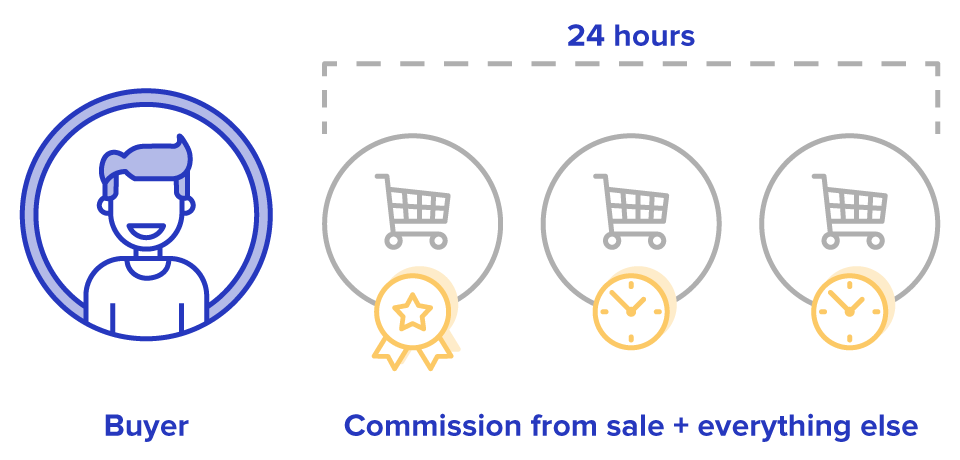
Amazon addiction — the desire to keep searching, clicking, and buying on Amazon — is evidently a real thing.
Research from JungleScout shows that roughly one in seven US consumers buy from Amazon seven or more times per week.
Why am I telling you this?
Because it’s one of the best things about the Amazon affiliate program.
Remember how I told you about the 24-hour cookie duration?
Well, that doesn’t just apply to the first product page your referrals land on.
It extends to any other products they seek out (and buy) within that same window.
That’s a pretty big deal.
So if a customer hits one of your affiliate links, snaps up a pair of sneakers, then also buys some ski goggles, a fishing rod, and a wireless printer, you earn commissions on every single one of those sales (provided their buying binge didn’t last longer than 24 hours).
Get used to checking your affiliate earnings and seeing a bunch of payments for products you’ve never promoted (or even heard of).
Cons of the Amazon Associates Program
Sorry, Jeff Bezos: it’s not all good news.
It would be remiss of us to overlook the fact that there are numerous issues with the Amazon affiliate program.
In fact, it’d be downright irresponsible.
So with that in mind, here are eight reasons you might not want to join Amazon Associates.
And if you’ve already encountered your fair share of these issues and are ready for something new, check out our step-by-step video guide to switching from Amazon to high-paying affiliate programs.
1No Link Cloaking
As far as Amazon is concerned, it’s the best website in the world.
So why would any Amazon affiliate ever hide their intentions by cloaking their links?
That’s Amazon’s perspective, at least.
In reality, there are perfectly legit reasons for cloaking your text links or banner ads by setting up a URL redirect.
It makes the URL shorter and rebrands it, which can make tracking easier and links look more trustworthy to readers.
But Amazon wants no part of it.
If you cloak your affiliate links without telling your audience that they’re heading straight to Amazon, don’t be surprised if you get kicked out of Amazon Associates quicker than you can say: “Come on, Jeffrey, you can do it.”
2Directing to One Product
Some affiliate programs allow you to link to pretty much any page you want.
That means you can send your audience to a category page full of lots of versions of essentially the same products, then they can choose the one they like best.
Surprise, surprise: Amazon doesn’t like that.
It only allows affiliate marketers to incorporate deep links to specific product pages.
While this can be a little restrictive, it’s not the worst thing.
If you’re promoting a product, it makes sense to send your audience to that product page anyway, right?
3Stock Issues in Certain Niches
This one can be endlessly frustrating, depending on your niche.
In an ideal world, the products you’re promoting are totally evergreen.
They never go out of date, so stock issues are never a problem, and you never need to update your affiliate links.
Unfortunately, that dream scenario is something of a rarity.
Because you have to link to one specific product page from one specific vendor, if that vendor encounters stock issues, your link becomes pretty useless.
So you need to find somewhere else to link to — otherwise, no commissions for you.
Now, think about how many Amazon links are on the average affiliate website.
They might have 10 in-depth articles, each containing links to 20 products.
That’s 200 different Amazon affiliate links to keep track of and update every time something drops out of stock.
Just thinking about it makes me want to scream.
Just thinking about it makes me want to scream.
However, plugins like Affilimate can help you out.
4Cookie Duration Last Only 24 Hours
I’ve covered this already, but to reiterate: the Amazon Associates cookie window is shorter than other programs.
A lot shorter.
Sure, it can technically be extended for up to 90 days if your referrals add-to-cart straightaway.
But let’s be honest: it’d be better for everyone (well, for affiliate marketers at least) if Amazon could just extend its standard cookie duration.
There’s next to no chance of that happening, though, so I wouldn’t bother getting your hopes up.
5Confusing Operating Agreement
If you spend any time on affiliate marketing forums (which you should; they’re a blast!), you’ll read countless complaints about the byzantine nature of Amazon’s Terms of Service for Associates.

It’s 4,000 words long.
It’s full of obscure terminology.
The formatting is awful, meaning key information is buried deep with huge chunks of text.
A lot of that text is written in all caps, for some reason.
It gets updated frequently.
And frankly, a lot of the advice is vague at best.
Like, you’d think, given Amazon’s UX brilliance it could cope up with a way to boil that information down into a handful of headline bullet points.
The worst thing, of course, is that if you fail to comply fully with the operating agreement, Amazon is extremely likely to ban you.
If the Amazon affiliate program is your main (or only) way to earn money, that’s obviously a huge concern.
6No Links in Email Newsletters
Email marketing is an absolute godsend for affiliate marketers.
According to Campaign Monitor, it drives an average ROI of $44 for every $1 you spend on it.
No other channel can match that.
But email marketing is yet another thing that Amazon doesn’t like very much.
Specifically, it doesn’t allow you to include affiliate links within emails.
So if you’ve got a successful newsletter with a big audience, you can’t monetize it directly.
Sure, it’s not exactly difficult to build a workaround.
You need to write a blog post or landing page incorporating all your Amazon links, then point your readers toward that instead.
But it’s still frustrating for any affiliates who’ve taken the time to build and grow an email newsletter.
7Low Commission Rates vs Other Programs
Again, I’ve already discussed the whole “commission rate” issue.
While Amazon gets a bad rep here — unsurprisingly, given its recent decision to slash commissions — the situation isn’t quite as bad as some people make out.
As I noted, 10% on luxury products is good money by anyone’s standards.
But there’s no getting away from the fact that most Amazon categories pay lower than other programs.
I’m not going to back up this point with an exhaustive comparison of different industries and affiliate programs.
You can find that sort of analysis elsewhere (including on this very site).
But here are a couple of examples:
Industry: Camping Gear
| Program | Commission | Cookie Duration |
|---|---|---|
| Amazon Associates | 3% | 24 hours |
| Cotopaxi | 10% | 30 days |
| REI | 5% | 15 days |
Industry: Photography
| Program | Commission | Cookie Duration |
|---|---|---|
| Amazon Associates | 4% | 24 hours |
| B&H Photo Video | 2% – 8% | 60 hours |
| Moment | Up to 12% | 3 days |
Industry: Woodworking
| Program | Commission | Cookie Duration |
|---|---|---|
| Amazon Associates | 3% | 24 hours |
| Highland Woodworking | 5% | 60 days |
| KC Tool | Up to 10% | 30 days |
What does this show us?
In most cases, you could earn higher commissions and get longer cookie windows by choosing niche affiliate programs rather than Amazon Associates.
8Weak Affiliate Marketing Support
This one sounds a bit harsh, so I’ll clarify things.
I don’t have a bad word to say about the support team at Amazon — to a person, they seem lovely.
They’re not the issue here.
The issue is with the aforementioned operating agreement.
It’s so vast, and covers so much ground, that it must be near-impossible for support agents to give clear instructions or advice.
Often, they’ll outright contradict something you’ve been told before.
This isn’t because Amazon gives bad training or hires the wrong people.
It just has so many rules.
9Adding Product Images Is a Pain
One of our biggest pet peeves with Amazon’s affiliate program is the process of adding product images.
For starters, you have to use Amazon’s own images.
And you can’t just download them and add your affiliate link. Instead, you need to use Amazon’s API or SiteStripe.
That means you’ve got no control over what image to use. And while Amazon offers large image sizes, in reality, they don’t always look great, and are sometimes too small for high-resolution screens.
10Pricing Problems
Amazon sells a lot of products. And the prices of those products change all the time.
Clearly, no affiliate marketer can afford to spend their time updating prices manually, so Amazon requires affiliates to use its API to pull in pricing information.
Unfortunately, it needs refreshing every 24 hours, and often causes issues with website caching. There’s a good chance it’ll cause you to breach Amazon’s terms of service at some point unknowingly.
Fortunately, there are plugins to make your life easier; we recommend Affiliatable.
11Finding Tracking IDs Can Be Tricky
Amazon allows you to create an unlimited amount of tracking IDs, meaning you can track your qualified sales per page, or even per single product.
So what’s the problem?
Well, you can only see 100 tracking IDs in the dashboard.
That means once you’ve created a lot of IDs, the older ones won’t show up within the dashboard anymore.
This prevents you from selecting older IDs from the drop-down list. Instead, you’ll need to track them somewhere else or search for them in the tracking ID dashboard, then copy/paste them into your Amazon link.
Oh, and you can only see a limited number of tracking IDs.
These issues apply to people who want to track IDs per pages or products.
Also, the reporting isn’t great, because you can only see every tracking ID or a maximum of 10 individual ones via the dashboard. If you want to see more, you’ll need to download your report.
12 International Payment Issues
Amazon is a reliable company and we haven’t seen any real horror stories about affiliates not receiving their commissions.
However, payment options are pretty limited compared to a lot of affiliate programs.
Until recently, international earnings — such as when an EU-based affiliate earns money via Amazon US Associate Programs — could only be paid by check or Amazon gift card.
The situation has improved somewhat, and now affiliates participating in Amazon’s US, UK, German, French, Italian, Spanish, or Canadian programs can be paid by bank transfer — but only if they’re based in one of 52 supported countries and territories across the US, UK, and eurozone.

So if you’re in Australia or Malaysia or South Africa or anywhere else not on that list, you’re stuck with gift cards or checks.
When to Use Amazon Associates
That just about wraps up our Amazon affiliate program review!
There’s just one more thing to cover:
When is it the “right choice” to sign up for Amazon’s affiliate program?
In my view, you can’t go wrong with Amazon if you’re new to affiliate marketing and you want to promote physical products.
The huge inventory and vast product category selection make your life so simple.
Sign up for Amazon Associates, create links, and you’re ready to go.
But once you’ve got a little more experience and confidence in your niche, you’ll naturally gravitate toward your favorite brands.
And those brands will almost always surpass the commissions that Amazon pays.
Still, there’s no need to close your Amazon Associates account at that point.
Feel free to use it alongside other affiliate programs as an additional revenue stream.
Just don’t rely on it as your only source of income.
Ready to build your first authority website or level up your existing online business?
Sign up for our free training, and we’ll teach you everything you need to master affiliate marketing in 2025!







